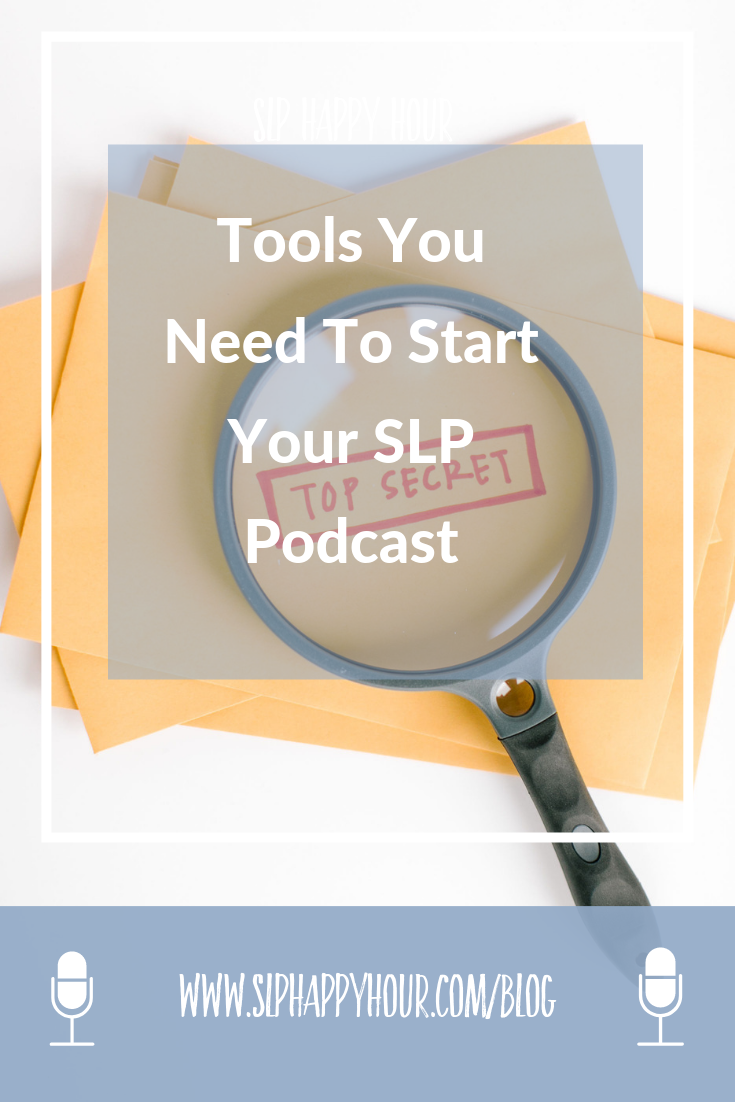We started our SLP podcast in early January. Since then, I've seen at least a dozen more SLP podcasts start up.
It's no wonder - having an SLP podcast is a great way to get your message out there. As SLPs, we can often be isolated, and podcasts instill a sense of community. As SLPs, we love to have good, high-quality conversations - and podcasts facilitate those as well.
But knowing where to start can be daunting. If you are just getting started (or you are already started but are just beginning to invest in equipment), this is the place for you to start.
Of note, I am not including links on physical products because they tend to go "dead" and no longer work, and I don't do affiliate links. As such, I trust your ability to use Google and Amazon to find these products.
1. Podcast Microphone
There are podcasts that don't record with a podcast microphone. I can tell the difference. If you can afford it, a podcast microphone is one of the first things you should buy. It elevates your sound quality and really makes your audio quality sound much more professional.
However, it's not just about the microphone - you also need to know how to use it (settings). We have episodes where we are talking away from the microphone (turning our heads as we talked) and you can tell. So, that is one lesson learned - make sure your head is pointed towards the mic. Also where you record matters - a smaller room with a carpet is ideal. We recorded a few episodes at Sarie's house, which has wood floors and an open floor plan, and immediately regretted it. We now exclusively record at my small, carpeted clinic office.
Microphones that are recommended include the Blue Snowball (it comes in a variety of colors) or the Blue Yeti. The Snowball will run you about $70 and the Yeti will run you about $127. If color matters to you, the snowball is pretty cute and comes in a ton of colors.
Of note - if you are recording at a separate location than your co-host, you will both need a microphone.
2. Pop Filter
A pop filter will make sure that your stops and sibilants don't blow out the sound and cause strange sound volume fluctuations. Unlike the microphone, in my opinion price doesn't really matter when it comes to pop filters.
There are several different types - some of which are just a soft cover for your podcast microphone (that's what we use). To find one of those, look up "microphone cover." You can get one for about $7.
If you want to get fancy, I've heard the Dragon Pad USA Pop Filter is pretty awesome, and it's about $12.
3. Audio Recording Software
You can use Garage Band (if you have a Mac), or Audacity. Audacity is a software you can download online for free. The learning curve is steep, and to be honest Sarie is really the expert here. I can do the basics, but it's only easy to use once you've used it for awhile and figured it out.
This summer, Sarie is going to give me lessons on Audacity so I can help her out a bit with the editing.
If you don't want to do your own editing, there are lots of people on Fiverr who will do it for you for a reasonable price, but you will still need to use Garage Band or Audacity to record the audio.
4. Recording an Interview
If your show is an interview show and you need to "call" someone and interview them, you'll need a way to do so. You can use Zoom, Skype (with Pamela to record), or even Google Chat. I use Zoom because I want to have one system that is both a platform to have the call and a way to record the call, all wrapped up in one system. I do have to pay for the Zoom pro version, which is $14.99 a month. I already do a lot of videochatting for the podcast and our Patreon page, so the price is worth it for me.
5. Podcast Hosting
You will need a podcast host. The host is the platform that "hosts" your website. In the same way that Instagram "hosts" all your Instagram posts and Facebook "hosts" your Facebook posts, you'll need a way to save and publish your audio once it's done, and that is your host.
The first episode, you'll need to push your RSS feed to all the podcast players. However, that's a bit complex for this blog post - so at this point, just note you'll need to do it. From then on, it'll happen automatically (podcast players will have your RSS feed). If this doesn't make sense yet, don't worry. You'll figure it out after your first episode is done.
We use Spreaker to host, because the first 3 hours were free. This is a good idea since most podcasts don't make it past the first three hours. Other options:
I haven't seen any compelling reasons one host is better than another, so check out prices and just pick one.
Getting Started
Honestly, getting started is the hardest part. I remember feeling overwhelmed during this initial start-up phase of our podcast. There was a point I honestly believed our podcast would never come out at all. It was hard work.
My hope with this blog post is that it allows you a bit more clarity in starting your own podcast, so you don't encounter as much of the overwhelm as we did.
There are some great SLP podcasts out there, and if you want to join in on the conversation it just takes hard work, research and a lot of sticking to it!


